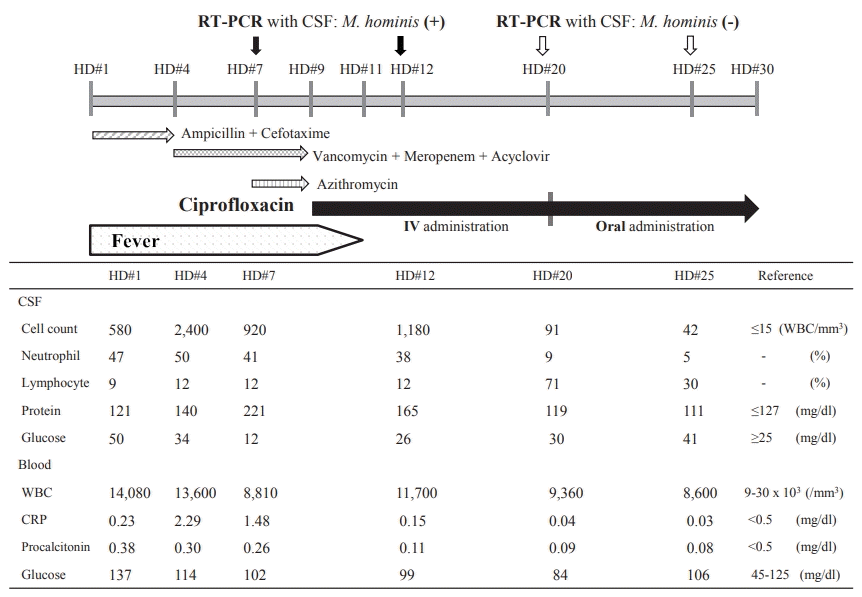A 3-day-old female child was hospitalized because of a fever and lethargy. She was born to a 29-year-old primigravida woman by uneventful vaginal delivery at 39 weeks of gestation after an uncomplicated pregnancy. Her birth weight was 3,730 g. On admission, she weighed 3,810 g and her body temperature was 38.7 °C. Her physical and neurological examinations were normal except for a fever and lethargy. Meningitis was diagnosed based on her laboratory findings, especially cerebrospinal fluid (CSF) examination, which revealed a white blood cell count of 580/mm3 (
Figure 1); therefore, ampicillin and cefotaxime were started. After 3 days, we repeated the laboratory examination and performed lumbar puncture because her fever persisted. The results indicated deterioration (
Figure 1); therefore, the treatment was switched to vancomycin, meropenem, and acyclovir. The initial blood, CSF, and urine cultures were negative. Furthermore, the PCR performed with the CSF sample was negative for bacteria, herpes simplex virus, and enteroviruses. On day 6, urine culture (on a special culture medium) revealed
M. hominis, which is susceptible to ciprofloxacin, doxycycline, josamycin, pristinamycin, and tetracycline; shows intermediate resistance/sensitivity to azithromycin, and is resistant to erythromycin and clarithromycin (
Table 1). Among the antibiotics that have been shown to be effective against
M. hominis, ciprofloxacin is the only drug that could be administered intravenously in our hospital. RT-PCR performed with the CSF sample on day 7 confirmed
M. hominis; thus, the patient was diagnosed with
M. hominis meningitis. On day 7, we added azithromycin, with intermediate efficacy against
M. hominis, considering the adverse effects of ciprofloxacin. However, because the fever persisted even after 48 hours, on day 9, the antibiotics were switched to ciprofloxacin 11 mg/kg/dose every 12 hours. After 2 days, the fever subsided. On day 20, the follow-up RT-PCR was negative for
M. hominis. After 11 days of intravenous administration, ciprofloxacin was administered orally for 10 days (
Figure 1). The patient did not develop seizures and there were no abnormal findings in brain magnetic resonance imaging.
M. hominis was not observed in the vaginal discharge of the mother. We speculated that this was because she received antibiotics during the postpartum period. However, because the baby was outborn, we could not exactly determine the kind of antibiotic that was administered to the mother. The patient was discharged on day 30 without complications. The patient showed normal growth and development at the 1-year follow-up.
 | Figure 1.Disease schedule: fever, laboratory findings, real-time polymerase chain reaction diagnosis (RT-PCR), and antibiotics for treatment. Abbreviations: CSF, cerebrospinal fluid; M. hominis, Mycoplasma hominis; HD, hospital day; IV, intravenous; WBC, white blood cell; CRP, C-reactive protein. 
|
Table 1.
The Susceptibility of Antibiotics in Mycoplasma hominis Culture: Growth (<10,000 CFU/Specimen)
|
Antibiotic |
Susceptibility |
|
Azithromycin |
I |
|
Ciprofloxacin |
S |
|
Clarithromycin |
R |
|
Doxycycline |
S |
|
Erythromycin |
R |
|
Josamycin |
S |
|
Ofloxacin |
S |
|
Pristinamycin |
S |
|
Tetracycline |
S |






 PDF
PDF Citation
Citation Print
Print



 XML Download
XML Download